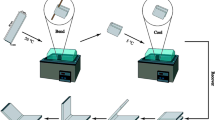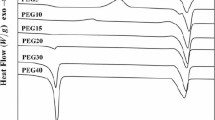Abstract
Shape memory polymers have attracted extensive attention attributable to their characteristics and abundant applications. In this study, shape memory behavior and characterizations of poly(ε-caprolactone) (PCL) blended with poly(vinyl chloride) (PVC) and poly(methylmethacrylate) (PMMA) in different proportions were investigated. Some characteristics of the blended polymers, such as attenuated total reflection (ATR) infrared (IR) spectroscopy, differential scanning calorimetry (DSC), thermogravimetric analysis (TGA), SEM, and optical microscopy (OM) were accomplished. Both melting temperature (Tm) and glass transition temperature (Tg) were affected by blending polymers. The Tm was decreased from 57 °C to 51 and 49 °C by adding 30% and 50% of PVC to PCL, respectively; moreover, adding 50% PMMA to PCL reduced the Tm of PCL to 55 °C. The TGA results revealed that the temperatures at which the mass of blended polymers begins to lose sharply depend on the ratio of the constituents. It is found that the PCL has a crystalline structure, while PVC and PMMA have an amorphous structure. Shape recovery was not detected in the PCL:PMMA (1:1) since the PMMA polymer did not dissolve in PCL, and therefore, it prevented the homogeneity of the blend. Besides, a shape memory recovering test was performed for PCL:PVC (7:3), whereby the blend showed an excellent strain recovery.








Similar content being viewed by others
References
Liu W, Zhang R, Huang M, Dong X, Xu W, Ray N, Zhu J (2016) Design and structural study of a triple-shape memory PCL/PVC blend. Polymer 104:115–122
Sokolowski W, Metcalfe A, Hayashi S, Yahia LH, Raymond J (2007) Medical applications of shape memory polymers. Biomed Mater 2:S23
Liu Y, Van Humbeeck J, Stalmans R, Delaey L (1997) Some aspects of the properties of NiTi shape memory alloy. J Alloys Compd 247:115–121
Jankauskaitė V, Laukaitienė A, Mickus KV (2008) Shape memory properties of poly (ε-caprolactone) based thermoplastic polyurethane secondary blends. Strain 2:26
Li J, Xie T (2010) Significant impact of thermo-mechanical conditions on polymer triple-shape memory effect. Macromolecules 44:175–180
Li W, Liu Y, Leng J (2016) Triple-shape memory effect of polystyrene based polymer blends. In: Proceedings of the 20th international conference on composite materials (ICCM20), pp 4411-4414
Hu J, Zhu Y, Huang H, Lu J (2012) Recent advances in shape–memory polymers: structure, mechanism, functionality, modeling and applications. Prog Polym Sci 37:1720–1763
Jenkins A, Kratochvíl P, Stepto R, Suter U (1996) Glossary of basic terms in polymer science (IUPAC recommendations 1996). Pure Appl Chem 68:2287–2311
Khan I, Mansha M, Jafar Mazumder MA (2018) Polymer Blends. Polym Polym Compos 2018:1–38
Kia HG, Verbrugge MW, Xie T, Rousseau IA (2016) Shape memory polymer containing composite materials. United States patent US 9(406):971
Langer RS, Lendlein A (2002) Shape memory polymers. Google Patents
Haruna H, Pekdemir ME, Tukur A, Coşkun M (2020) Characterization, thermal and electrical properties of aminated PVC/oxidized MWCNT composites doped with nanographite. J Therm Anal Calorim 139:3887–3895
Chastain SR, Kundu AK, Dhar S, Calvert JW, Putnam AJ (2006) Adhesion of mesenchymal stem cells to polymer scaffolds occurs via distinct ECM ligands and controls their osteogenic differentiation. J Biomed Mater Res A 78:73–85
Xie J, Marijnissen JC, Wang CH (2006) Microparticles developed by electrohydrodynamic atomization for the local delivery of anticancer drug to treat C6 glioma in vitro. Biomaterials 27:3321–3332
Yu WJ, Lin CC (2001) Comparison of protein loaded poly (ε-caprolactone) microparticles prepared by the hot-melt technique. J Microencapsul 18:585–592
Campos Ad, Franchetti SMM (2005) Biotreatment effects in films and blends of PVC/PCL previously treated with heat. Braz Arch Biol Technol 48:235–243
Reignier J, Huneault MA (2006) Preparation of interconnected poly (ε-caprolactone) porous scaffolds by a combination of polymer and salt particulate leaching. Polymer 47:4703–4717
Mareau VH, Prud’Homme RE (2003) Growth rates and morphologies of miscible PCL/PVC blend thin and thick films. Macromolecules 36:675–684
Jeong HM, Song JH, Lee SY, Kim BK (2001) Miscibility and shape memory property of poly (vinyl chloride)/thermoplastic polyurethane blends. J Mater Sci 36:5457–5463
Rabani G, Luftmann H, Kraft A (2006) Synthesis and characterization of two shape-memory polymers containing short aramid hard segments and poly (ε-caprolactone) soft segments. Polymer 47:4251–4260
Chen T, Kusy R (1997) Effect of methacrylic acid: methyl methacrylate monomer ratios on polymerization rates and properties of polymethyl methacrylates. J Biomed Mater Res 36:190–199
Abdelrazek E, Hezma A, El-Khodary A, Elzayat A (2016) Spectroscopic studies and thermal properties of PCL/PMMA biopolymer blend. Egypt J Basic Appl Sci 3:10–15
Ma W, Zhang J, Wang X, Wang S (2007) Effect of PMMA on crystallization behavior and hydrophilicity of poly (vinylidene fluoride)/poly (methyl methacrylate) blend prepared in semi-dilute solutions. ApSS 253:8377–8388
Si H, Sato T, Tominaga Y, Asai S, Sumita M (2006) The effect of high-pressure carbon dioxide treatment on the crystallization behavior and mechanical properties of poly (l-lactic acid)/poly (methyl methacrylate) blends. Polymer 47:3954–3960
Agari Y, Anan Y, Nomura R, Kawasaki Y (2007) Estimation of the compositional gradient in a PVC/PMMA graded blend prepared by the dissolution–diffusion method. Polymer 48:1139–1147
Aouachria K, Belhaneche-Bensemra N (2006) Miscibility of PVC/PMMA blends by vicat softening temperature, viscometry, DSC and FTIR analysis. Polym Test 25:1101–1108
Zhou C, Si QB, Ao YH, Tan ZY, Sun SL, Zhang MY, Zhang HX (2007) Effect of matrix composition on the fracture behavior of rubber-modified PMMA/PVC blends. Polym Bull 58:979–988
Al-Mulla A, Shaban HI (2007) Degradation kinetics of poly (ethylene terephthalate) and poly (methyl methacrylate) blends. Polym Bull 58:893–902
Kailas L, Bertrand P (2006) End group effect on surface and interfacial segregation in PS-PMMA blend thin films. ApSS 252:6648–6651
Jin X, Zhang S, Runt J (2004) Broadband dielectric investigation of amorphous poly (methyl methacrylate)/poly (ethylene oxide) blends. Macromolecules 37:8110–8115
Yılmaz S, Coşkun M (2017) Thermal and electrical behaviors of acid functionalized MWCNT/ABC-type triblock copolymer grafted-MWCNT nanocomposites. J Macromol Sci A 54:791–795
Lipik VT, Abadie MJ (2010) Process optimization of poly (ε-caprolactone) synthesis by ring opening polymerization. Iran Polym J 19:885–893
Balke TS (1972) The free radical polymerization of methyl methacrylate to high conversions. Doctoral Dissertation, Open Access Dissertations and Theses Community
Pekdemir ME (2020) Poli (Vinil klorür)/Fe3o4 manyetik nanopartikül kompozitlerinin sentezi, termal ve elektriksel özelliklerinin incelenmesi. Afyon Kocatepe Üniversitesi Fen Ve Mühendislik Bilimleri Dergisi 20:802–809
Pekdemi̇r M, Coşkun M (2020) Manyetik Fe3O4 nanopartiküllerinin siyanurik klorür yoluyla poli (ε-kaprolakton)’ a bağlanmasi, termal ve manyetik özelliklerinin incelenmesi. J Inst Sci Technol 10:2730–2739
David G, Turin-Moleavin I, Ursu LE, Peptanariu D, Ailincai D (2018) Multilayer biopolymer/poly (ε-caprolactone)/polycation nanoparticles. Iran Polym J 27:517–526
Ahmadi M, Behzad T, Bagheri R (2017) Reinforcement effect of poly (methyl methacrylate)-g-cellulose nanofibers on LDPE/thermoplastic starch composites: preparation and characterization. Iran Polym J 26:733–742
Kok M, Demirelli K, Aydogdu Y (2008) Thermophysical properties of blend of poly (vinyl chloride) with poly (isobornyl acrylate). Int J Sci Technol 3:37–42
Meng H, Li G (2013) A review of stimuli-responsive shape memory polymer composites. Polymer 54:2199–2221
Mather PT, Luo X, Rousseau IA (2009) Shape memory polymer research. Annu Rev Mater Res 39:445–471
Zhang H, Wang H, Zhong W, Du Q (2009) A novel type of shape memory polymer blend and the shape memory mechanism. Polymer 50:1596–1601
Hayashi S, Fujimura H (1991) Shape memory polymer foam. Google Patents
Balu R, Kumar T, Ramalingam M, Ramakrishna S (2011) Electrospun polycaprolactone/poly (1, 4-butylene adipate-co-polycaprolactam) blends: potential biodegradable scaffold for bone tissue regeneration. J Biomater Tissue Eng 1:30–39
Thomas S, Grohens Y, Jyotishkumar P (2014) Characterization of polymer blends: miscibility, morphology and interfaces. John Wiley & Sons, New York
Kong Y, Ma Y, Lei L, Wang X, Wang H (2017) Crystallization of poly (ε-caprolactone) in poly (vinylidene fluoride)/poly (ε-caprolactone) blend. Polymers 9:42
Ajami Henriquez D, Rodríguez M, Sabino M, Castillo RV, Müller AJ, Boschetti de Fierro A, Abetz C, Abetz V, Dubois P (2008) Evaluation of cell affinity on poly (L-lactide) and poly (ε-caprolactone) blends and on PLLA-b-PCL diblock copolymer surfaces. J Biomed Mater Res A 87:405–417
Santos J Jr, Pita V, Melo P, Nele M, Pinto J (2013) Effect of process variables on the preparation of artificial bone cements. Braz J Chem Eng 30:865–876
Dixit M, Mathur V, Gupta S, Baboo M, Sharma K, Saxena N (2009) Investigation of miscibility and mechanical properties of PMMA/PVC blends. J Optoelectron Adv Mater Rapid Commun 3:1099–1105
Wu BM, Borland SW, Giordano RA, Cima LG, Sachs EM, Cima MJ (1996) Solid free-form fabrication of drug delivery devices. J Controlled Release 40:77–87
Author information
Authors and Affiliations
Corresponding author
Rights and permissions
About this article
Cite this article
Pekdemir, M.E., Öner, E., Kök, M. et al. Thermal behavior and shape memory properties of PCL blends film with PVC and PMMA polymers. Iran Polym J 30, 633–641 (2021). https://doi.org/10.1007/s13726-021-00919-8
Received:
Accepted:
Published:
Issue Date:
DOI: https://doi.org/10.1007/s13726-021-00919-8




